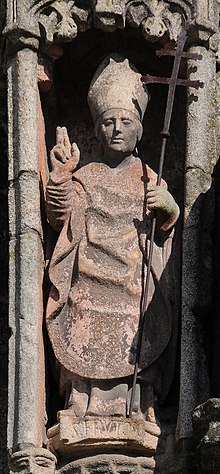Fructuosus of Braga
| Saint Fructuosus of Braga | |
|---|---|

Statue of Fructuosus on a façade of Braga Cathedral
|
|
| Bishop Confessor |
|
| Born | early 7th century Visigothic Kingdom of Hispania |
| Died | 16 April 665 Braga (present-day Portugal) |
| Venerated in |
Roman Catholic Church Eastern Orthodox Church |
| Feast | 16 April |
| Attributes | Monk with a stag |
Saint Fructuosus of Braga was the Bishop of Dumio and Archbishop of Braga, a great founder of monasteries, who died on 16 April 665. He was the son of a Visigothic dux in the region of Bierzo and he accompanied his father at a young age on certain official trips over his estates.
His relationship with the kings of his time was not always happy one. In 652, he wrote what was apparently a second letter to King Recceswinth asking for the release of political prisoners held from the reign of King Chintila, some of whom had languished in prison until the reign of King Erwig. In 656, he undertook to plan for a voyage to the Levant. However, according to the new laws enacted by King Chindasvinth, it was illegal to leave the kingdom without royal permission. One of the few disciples privy to his plans had given him up to authorities and Fructuosus was subsequently arrested and imprisoned. He was later present at the Eighth Council of Toledo in 653, in place of Bishop Riccimer of Dumio. It was at this Council that St Fructuosus raised the issue of political prisoners once again.
After the death of Bishop Riccimer, Fructuosus succeeded him in the See of Dumio. At the subsequent Tenth Council of Toledo (656), the clergy of Dumio complained that Riccimer's will, which dispensed church rents to the poor and freed the episcopate's slaves, had impoverished the See. The Council agreed that, by not providing compensation, Bishop Riccimer had obviated his duty and the acts of his will were rendered invalid. They gave the job of correcting the problem to Fructuosus and commanded him to take moderation in the case of the slaves. At the same Council, Archbishop Potamius of Braga was remanded to a monastery for licentiousness and his archdiocese was given to St Fructuosus on 1 December 656.
Fructuosus dressed so poorly as to be mistaken for a slave and he even received a beating from a peasant, from which he was only saved by a miracle (according to the monastic chroniclers). He established the monastery of Compludo in the El Bierzo region, and several other monastic foundations. Some of these were located in Gallaecia, but he subsequently established monasteries farther south in the Iberian Peninsula. The location of these foundations "is not known with complete certainty." Fructuosus established Rufiana or the Monasterium Rufianense in El Bierzo, as well as a monastery known as Visoniense and another known as Peonense. It has been speculated that these may refer to San Pedro de Montes, San Fiz de Visoña, San Juan de Poyo, respectively. In Baetica, he established a monastery at the Island of Cádiz and one called Nono (location unknown).
...
Wikipedia
